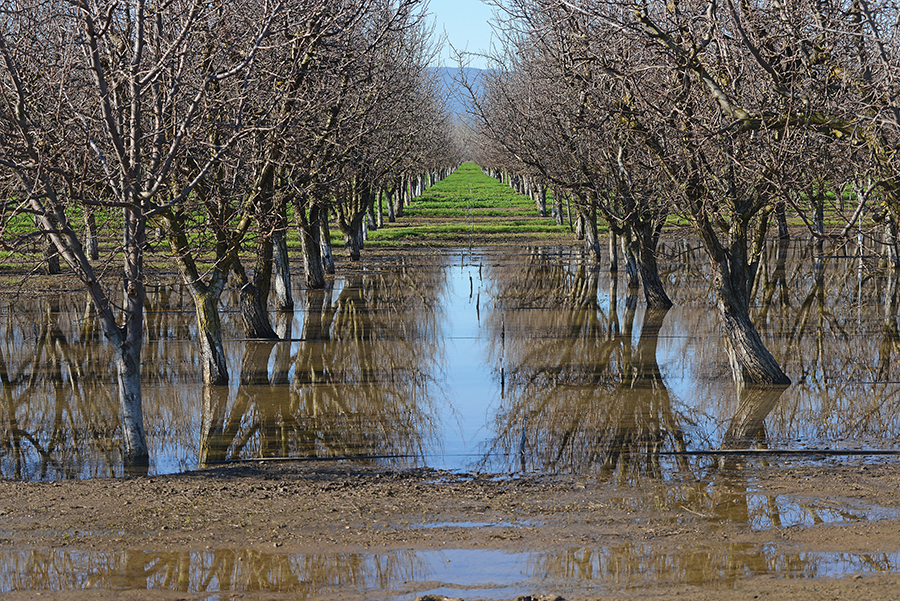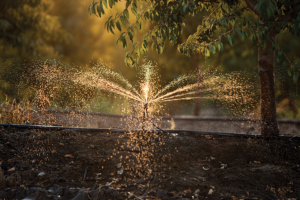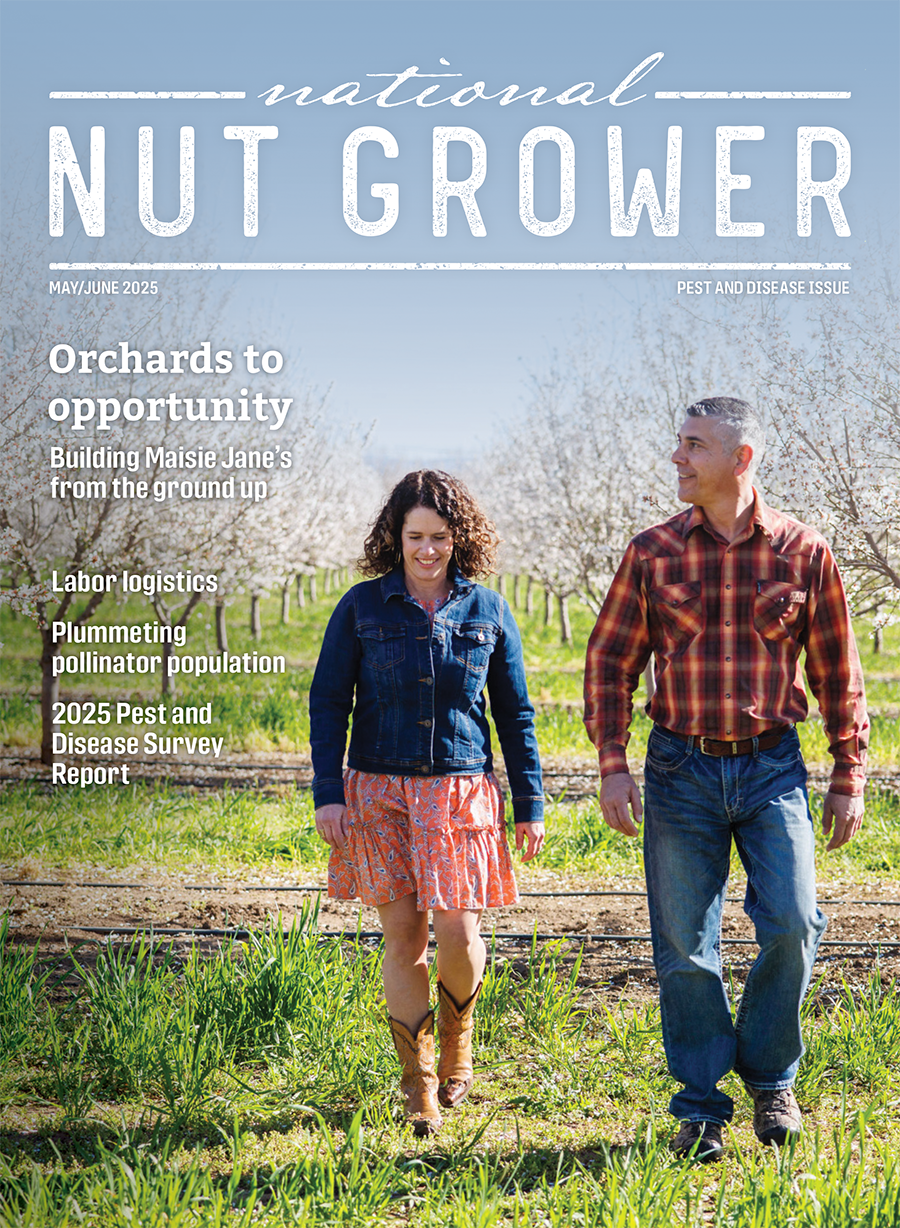
Tools and sensors can help tree nut growers with water stress
One big challenge for nut growers is identifying water stress and timing irrigation in ways that make sense.
That’s the opinion of Mallika Nocco, assistant adjunct professor in UC Davis’ Department of Land, Air and Water Resources.
“What I think a lot of growers struggle with is how to incorporate estimates of stress into their irrigation schedule,” she said. “From events that I’ve done throughout the Central Valley, it sounds like a lot of them put together their irrigation schedules for a season and stick to them, and incorporating stress would take a lot more thought and labor I know some folks just don’t have. But there are times when it makes sense to incorporate the measurements.”
With almonds, for example, Nocco said during the hull-split period, where growers want to intentionally stress their trees, it would be a savvy time to incorporate estimates of water stress, either using pressure potential measurements or sensors that can help estimate water potential.
“More people today are accessing remote sensing sources,” she said. “There are companies who can provide tools so growers can access stress data around hull-splits that can be informative to pull back irrigation.”
Another way useful for growers to monitor water stress is knowing when to activate irrigation in the spring.
“With a wet year, you’re going to have that full moisture profile all filled up, so it would be wise to wait until it’s an appropriate time to turn on that irrigation so that we can have root development, take advantage of some oxygen, as well as water in those soils, and not just over-water them right off the bat,” Nocco said.
Tools to know
Gurreet Brar, a Fresno State assistant professor of pomology who specializes in pistachio physiology and horticulture, noted that while recent wet weather has helped build California reservoir storage levels and get the snow up in the Sierra, the water issues are far from over.
“With SGMA regulations (California’s 2014 Sustainable Groundwater Management Act) imposing groundwater pumping restrictions in many areas of the Central Valley, many orchards can still face water stress during peak demand months this summer,” he said.

Brar points to online decision support tools like CropManage which utilize evapotranspiration data and crop-specific stress indices to help growers make informed decisions for precision irrigation.
“Tools and strategies like micro- irrigation with precision, regulated deficit irrigation, and plant-based water stress monitoring have helped the industry in not only saving water, but also increasing crop water use efficiency and mitigating disease pressure,” Brar said. “Remote sensing tools like satellite imagery are helping growers and researchers in better estimating crop water use or crop water stress. Also, UAV imagery in the NIR spectrum is being used for precision irrigation.”
Ken Shackel, a UC Davis plant scientist, agreed California’s recent record rains may not make water stress as big an issue this year, but growers are paying strict attention to their trees, managing the water closely.
“There’s a lot of buzz and companies selling all kinds of different gadgets that they say measure plant stress,” he said. “Most of these gadgets will respond if you take a tree and stop watering it; the problem has been to develop a tool that is consistently telling you when it’s responding and when it’s not. The consistency has been the hard thing, especially for almonds and walnuts.”
The gold standard, Shackel said, is the pressure bomb, which provides a good number for whether the tree is stressed or not and how much. Plus, it doesn’t change through the season.
The tried-and-true gold standard way to measure water stress in nut trees is to take estimates of water potential, which Nocco admitted can be a hassle, as they are time-consuming and require someone trained to go out and commit time to taking the measurements.
“Some other things to come out recently are different tensiometer sensors, which are providing continuous estimates of stem water potential based on a single tree,” she said. “There are a few different companies selling these now, and there are slight differences to how they are working.”
Over the last 10 years, Shackel noted that the FloraPulse sensor, a tensiometer, has been the best tool he’s found to mimic the measurement that the pressure chamber takes on a different scale and is becoming much more popular among tree nut growers.
Nocco and her colleague, Isaya Kisekka, have been comparison testing sensors for stem water potential, and recently submitted a paper for peer review based on their look into how the tools were being used on Central Valley almond trees.
“What we know now is that the sensors are really good at capturing the variability of relative stress, but there are differences and we are still trying to understand the relative magnitude,” Nocco said. “On the same day, if you go out and take a reading on stem water potential, and compare it to the readings from one of the sensors, that’s what we are evaluating.”
Remote sensing is also being utilized more, Shackel says, and this utilizes satellite data, drone data or airplane data to try to map water stress at the tree. Thermal imaging is involved.
“It gives you a different version of water stress because you’re able to look at it for the whole orchard and can detect problem areas,” he said. “They also are helpful for understanding issues with distribution uniformity.”
Ongoing research
Nocco is also currently part of a large collaboration of researchers involved in an irrigation and water project tailored to tree crops called Tree-Crop Remote Sensing of Evapotranspiration Experiment (T-REX), which is trying to understand crop water use as best as possible, and part of that is understanding crop water stress.
“The future I would hope for from this experiment is to have a tree-scale estimate of evapotranspiration that’s continuous,” she said, explaining her research group used drones to make scale maps. “We can also get some understanding of crop water stress when we have this high- resolution data. We can also look at how those rates change over time and how they are different from trees around it. This is how we can understand if a particular tree is stressed using evapotranspiration.”
The measurements can also help compare the actual water use to the evaporative demands of the environment.
“If we see a high level of evaporative demand and a low level of evapotranspiration, that means the tree is not meeting the demand of the environment because it doesn’t have enough water,” Nocco said. “We are trying to develop tools that will be accessible and inform those working in the space with the best available scientific data.”









